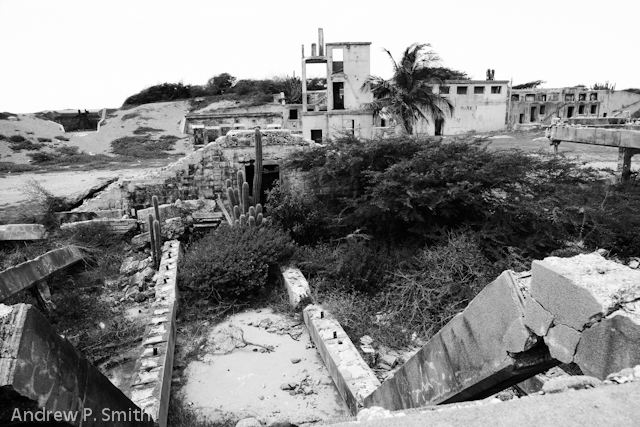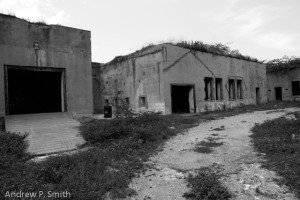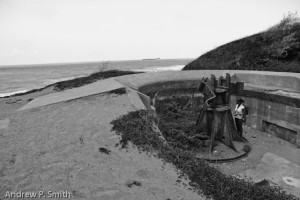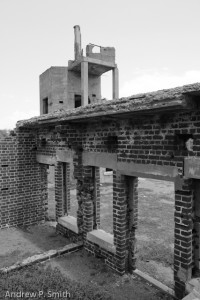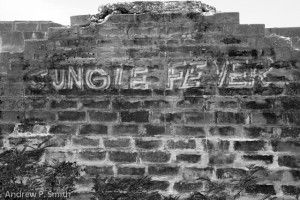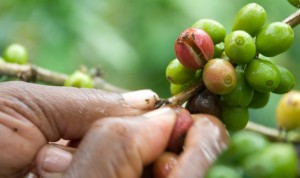A spirit of camaraderie characterised the three-day River Breeze Photography workshop held last weekend in the Buff Bay Valley of Jamaica’s Blue Mountains. Based at River Breeze cottage at Cascade, the three participants immersed themselves (at times literally) in all of the activities. Friday morning saw sessions that focused on DSLR camera familiarisation, creative composition and light interpretation and included a short climb to the nearby One Drop Waterfall. The day ended with a night photography session on the grounds of the cottage. [slideshow id=8]It was an early wake-up the next morning to catch sunrise at the upper Buff Bay Valley followed by a critique session. After lunch we made our way to the Maroon village of Charles Town where the students were exposed to an integral part of Jamaica’s history and culture. That night ended in the coastal town of Buff Bay, formerly the capital of the defunct parish of St. George. Sunday was a full day, with some of the stops including Fish Dun waterfall, Birnamwood Anglican Church and Avocat. At the end of the weekend, the portfolios were presented and all of the students had very strong work that highlighted their creativity and drive as well and also illustrated the Buff Bay valley. Here is a link to two of the students’ work and above are the students in action.
Category Archives: Heritage
Fort Rocky
Fort Rocky is an abandoned fort located on Jamaica’s Palisadoes strip near the old pirate community of Port Royal. It is a forgotten and dilapidated part of the long and proud military heritage of this area.
Although Port Royal is well-known as being described in the 17th century as “the wickedest city in the world” , it also has a long history as a military post. The British naval heritage is well represented by Fort Charles and Jamaica’s Coast Guard currently has its headquarters here.
Facts regarding the date of its construction are unclear. According to Merrick Needham in a letter to the Daily Gleaner in September 2007, it was built just before the first world war and up to the end of World War II, it consisted of “five six-inch coastal guns” and “had barracks accommodation for all of 82 officers and other ranks”. However, according to the web-site of the Jamaica National Heritage Trust that states that: “Fort Rocky, the last of great forts, was constructed during World War II. It was erected as part of the effort to prevent German invasion on the island”.
As can be seen from these photos taken earlier this month, the location is still intact and with the right plan, it could become an attraction for those interested in military history. However, when I visited the site two weeks ago, there was no informational sign about the fort visible on the Palisadoes main road. The only sign present stated that it is a venue available for hosting events.
Small Farming in Jamaica’s Blue Mountains
Scattered throughout eastern Jamaica’s mountainous interior are small farmers that face innumerable challenges to make a living on some of the island’s most challenging terrain. At 45 kilometres long and 20 kilometres wide, the Blue Mountain Range is one of the Caribbean’s longest continuous mountain ranges and Jamaica’s highest and largest with many of the peaks on the Grand Ridge range from 900 to 2256 metres. Many of the villages here are peopled by descendants of slaves who moved from the coastal plantations into the interior after emancipation from slavery in 1838. Crops grown include cash crops such as potatoes, bananas, carrots, tomato and yam and the world-famous coffee named for this range.
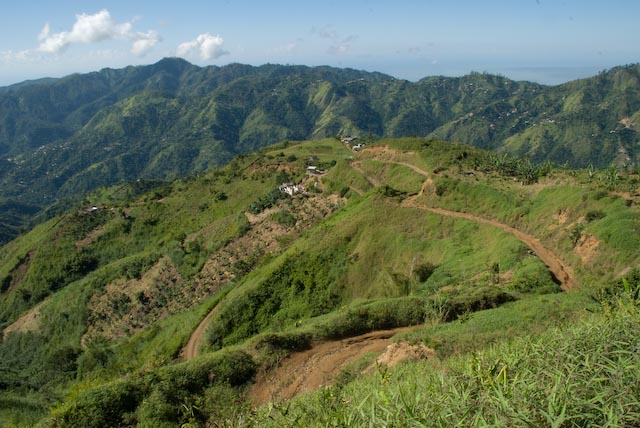
The community of Halls Delight in the road from Mavis Bank to Westphalia in the Blue Mountains of St. Andrew.
Originally introduced to Jamaica in 1725 from Martinique, commercial coffee cultivation spread to the Blue Mountains where the altitude of over one thousand metres and the cool climate resulted in coffee berries taking a longer time to mature than at lower altitudes. This resulted in the coffee’s unique flavour and led to the establishment of large coffee estates and factories, some of which still exist today. It is to these factories that small farmers sell their ripe coffee berries.
One might assume that cultivating the world’s most expensive coffee would lead to great wealth for those who grow the crop. While this might be true for the large estates, this is not so for the small coffee farmers who have to sell their berries to licensed processing factories which process and sell the beans locally and overseas. Although one pound of roasted Blue Mountain coffee beans is sold for US$50.00 this sale price is not transferred to the small farmers. As Bertram, a coffee farmer from Penlyne Castle in St. Thomas claims, “I could make more money running a taxi for six months than from coffee for a year.”
In addition to the economic obstacles faced by farming, the residents of the Blue Mountains face many other challenges related to their geography, which were highlighted in the past decade. From 2004 to 2008, hurricanes and tropical storms resulted in landslides, the destruction of buildings and the disruption of water supplies. Much of this is exacerbated by poor farming practices on the steep and fragile slopes which led to land degradation and erosion. This has resulted in many of the communities being necessarily self-sufficient, since they cannot always rely on the authorities to rebuild roads or repair the infrastructure.
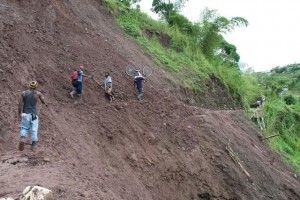
A cyclist and pedestrian make their way across one of the landslides at Cascade, Portland. After five years of neglect, this road has began to be repaired in 2010 after it occurred in 2004.
Yet there is potential for other sources of income for residents of these mountains. The unique biodiversity of the Blue Mountains resulted in it forming the main component of the 76,000 hectare Blue and John Crow Mountains National Park which was established in 1993. Thus, many residents believe that the Blue Mountains have great potential for heritage and adventure tourism, but requires sustained more marketing from Jamaica’s tourism industry. If this is done the residents believe that they will not be left to the economic and environmental vagaries to which they are now subjected.
